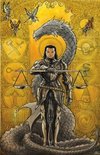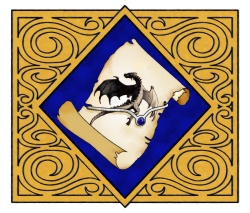Guild:Web of Angadar
| Part of the series on Religious Orders |
| The Nine |
|---|
| Intermediate |
| Lesser |
| Demi |
| Related subjects |
|
As a counterbalance to Andrinor’s Trust, the Web of Angadar is both an attractor and repellent for mages. Its projects for seeking, researching, and storing arcane knowledge rival those of the Great Library of Mikona, but its anti-Andrinor stance can incriminate any member of The Trust that becomes too closely associated with the Angadarians. Additionally, when the creation of The Trust robbed the hopes of Angadar and his followers for controlling magic, the psionic prowess of the deity and his followers came more to the forefront. Much research on accessing magical energies through psionics came from this dynamic as a means of trying to access the Vortex of Mortal Magic without the knowledge or control of Andrinor. Success in this regard has been partial, and accessing magic through psionic intervention seems to still require some acquiescence from Andrinor, but the goal of using “psi-magic” to gain independence persists.
HistorySoon after the ascension of Andrinor in 1950 A.O.D, there was palpable dissent among mages, including Angadar who in addition to being a deity was known during his mortal years as a powerful user of magic and psionics. Given the callous way in which the new god of magic dispatched the old mage orders and began to play careless jokes on his casters, mages were itching to seek revenge or undo the nightmare in which they were living under a Chaotic deity of magic who regarded them as his playthings. The followers of Angadar offered an alternative to the distraught community of arcane magic uses: figure out a way to put Angadar in Andrinor’s place where he belongs, and things will be much more orderly and predictable when it comes to magic. During these early years it was mostly the clerics of Angadar and a few of his loyal mage followers that tried to rally the remnants of the old mage orders into reforming and rising up to take magic from the new upstart. Mages found this proposition to be a better one than the prospect of practicing their craft under Andrinor for the rest of their lives and this made for a groundswell of attention at first. Ultimately however, these efforts proved unsuccessful. Perhaps because Andrinor came to the realization that he was being callous and putting himself in danger, he started to behave more responsibly (as any Chaotic god could) and began a series of events with a false Vortex of Chaos designed to cause groups of mages to race one another in efforts to obtain its power as a contrived exercise, which then led to the formation of Andrinor’s Trust and the new Nine Orders of Magic. The formation of Andrinor’s Trust gave relief to most mages who doubted the new way of doing things could work. These mages joined The Trust willingly and enthusiasm for Angadar’s case for usurping control of magic dwindled. Nevertheless, some small number of them did not wish to accept the new status quo. At certain points in history, these rebels against the god of magic were hunted down and had to go into hiding, and ultimately, they were scattered throughout Negaria thinly enough to be regarded as no threat. It was the churches of Angadar that revived the cause and coalesced the efforts of restoring control of magic to its rightful place, with the help of an elven woman and cleric of Angadar named Amonien Amana. Using the churches as cover, Amonien and the other clerics of Angadar with help and support from Grantir, the main city of his worship, organized mischief and misdirection events to disrupt The Trust and collect information from it. The disruption and interference caused within The Trust continues into present times along with further plots to bring about the destruction of Andrinor and the reorganization of the control of magic. OrganizationThe Web of Angadar is a hierarchical organization divided into three tracks: one contains the clergy members that additionally belong to the Church of Angadar, another contains the members who use arcane magic and psionics, and the third contains the lay people who have any other type of specialty. At the top of the hierarchy is Amonien Amana and her lieutenants who organize the three branches and their activities from the group’s base city of Grantir and from its two other strongholds located in the cities of Mikona and Elysia. Despite its history, the Web of Angadar is not an organization that exists solely for defeating Andrinor and remaking The Trust, although this tends to be its most reputable focus. Angadar’s mantle of deific control covers several aspects: Arcane Knowledge, Deceit, and Trickery. These areas of control all have interesting areas of overlap and support, and the Web of Angadar seeks to employ them accordingly. Specifically, the organization’s mission is to acquire forgotten arcane knowledge in the form of spells and artifacts, research new spells and create new artifacts with interesting properties, and manipulate the affairs of any other organization or entity in ways that could benefit the first two missions. One particular area of concentration for research is on psi-magic, which aims to access magical energy through the use of psionics. As a subject near and dear to the heart of most any mage, the pursuit of arcane knowledge acts as the main draw for mages to take the risk of joining the organization and potentially defying The Trust. The Web of Angadar works to gather arcane knowledge from the deepest corners of the globe so it can be stored deep within the main magical library it holds within the underground levels of the city of Grantir. The rumor is that the library is expansive and occupies two planes at the same time, the Prime Material Plane and a spot in the Nine Hells as part of Angadar’s personal library of arcane secrets from all around the multiverse. Access to information such as this is not possible within The Trust, even with its own extensive libraries and the Great Library of Mikona which contains general information about mundane subjects. With most magical libraries, there is usually an accompanying laboratory. Within the bowels of Grantir near the Library of Angadar is one such laboratory with mythical accommodations and equipment. Members of the Web of Angadar are eligible for time to use it to do their experiments, and the lab is large enough for a great number of these researchers to conduct independent studies. The arts of Deceit and Trickery are also employed by members in construction of ruses to disrupt The Trust, but the Web of Angadar is also peripherally involved in most conflicts around Negaria. This is partly because of Angadar’s extensive interrelations and dealings with other deities and nations, but also partly because the members of this organization are renowned for their arts of disguise, illusion, and intrigue. In many cases they rival the orcs of Brekon and the rogues of the Ravens Guild in these pursuits. The clerical branch of the organization acts to support the other two branches but also to cover up any manipulations and crimes committed by the group. Their duty is to present a gentle face to the worshipers and non-members and give a veneer of guilt-free innocence. Of course, all beings versed in basic mythology know that Angadar is indeed a god of trickery and deceit. The clergy’s mission is to make those acts harder to find. They also serve to keep The Trust at bay which frees up any arcane magic-wielding members to pursue other aspects.
The Web of Angadar InformationAlignment: Angadar is lawful evil, but any non-chaotic may join. Neutrals will have a more difficult time joining, especially Neutral Good and True Neutral. Base of operations: Our temple in the Elysian Nobles' District, and most of the members are based in either Elysia or T'Nanshi. How to contact us: Leave a note at the Temple of Angadar in Elysia, Nobles' District. Should be addressed to Rhys'lryn Si'Vidicuss (PM [1]). What we do: Angadar is certainly one of the more interesting intermediate deities in regard to the diversity his mantles--Arcane Knowledge, Trickery, and Deceit. Arcane Knowledge: This branch of the Web specializes in arcane research. This should not be confused with mortal magic; Angadarians working under this mantle are interested in such things as portals, artifacts and relics, constructs, the creation of magical devices, the creation of enchanted items, etc. Mortal magic, i.e., the casting of spells, is Andrinor's field. Trickery and Deceit: Angadar believes that above all else, knowledge is power. Knowledge comes in many forms, and in some cases needs to be obtained through subtle means. Angadarians working under these mantles gather information, forge and break alliances, and work quietly to further Angadar's goals and influence. All classes are welcome to join, though stealth skills are helpful. What to expect: This is a tightly-knit group, and the nature of its operations requires absolute trust in one another. As a result, potential recruits are rigorously analyzed for three main traits: ingenuity, commitment, and discretion. This holds true regardless of which mantle you hope to work within. Those who wish to join will usually be asked to conduct research under someone's leadership, whether of an arcane sort or another, less obvious, variety. We work together on multiple projects, and focus on applying our influence to maximize its impact and make things happen. More on Angadar here. |

